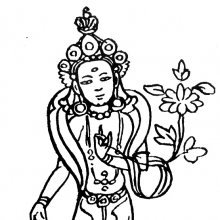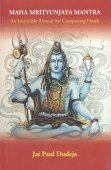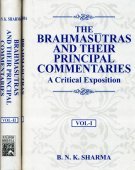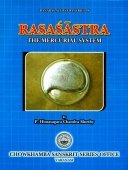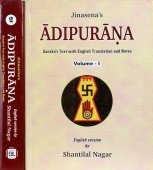Smriti, Smṛti: 46 definitions
Introduction:
Smriti means something in Buddhism, Pali, Hinduism, Sanskrit, Jainism, Prakrit, Marathi, Hindi. If you want to know the exact meaning, history, etymology or English translation of this term then check out the descriptions on this page. Add your comment or reference to a book if you want to contribute to this summary article.
The Sanskrit term Smṛti can be transliterated into English as Smrti or Smriti, using the IAST transliteration scheme (?).
Alternative spellings of this word include Smrati.
Images (photo gallery)
In Hinduism
Dharmashastra (religious law)
Source: Wisdom Library: Dharma-śāstraSmritis mean “that which has to be remembered”. They refer to a specific set of sacred Hindu texts. They are composed by humans (unlike the Vedas) and are designed to guide a person through their daily lives.
The 18 smṛti’s of Hindu scriptures are:
- Āṅgirasa Smṛti
- Vyāsa Smṛti
- Āpastamba Smṛti
- Dakṣa Smṛti
- Vishnu Smṛti
- Yāgyavalkya Smṛti
- Likhita Smṛti
- Samvartta Smṛti
- Shanka Smṛti
- Bṛhaspati Smṛti
- Atri Smṛti
- Kātyāyana Smṛti
- Parāṣara Smṛti
- Manu Smṛti
- Aushanasa Smṛti
- Hārita Smṛti
- Gautama Smṛti
- Yama Smṛti

Dharmashastra (धर्मशास्त्र, dharmaśāstra) contains the instructions (shastra) regarding religious conduct of livelihood (dharma), ceremonies, jurisprudence (study of law) and more. It is categorized as smriti, an important and authoritative selection of books dealing with the Hindu lifestyle.
Purana and Itihasa (epic history)
Source: archive.org: Puranic EncyclopediaSmṛti (स्मृति).—The sovereign deity of remembrance. It is mentioned in Mahābhārata, Śalya Parva, Chapter 46, Verse 64, that this goddess Smṛti had walked in front of the army of Subrahmaṇya. Smṛti was the wife of Aṅgiras. Four daughters, named Sinīvālī, Kuhū, Rākā and Anumati, were born to Aṅgiras by his wife Smṛtidevī. (Viṣṇu Purāṇa, Aṃśa 1, Chapter 10).
Source: archive.org: Shiva Purana - English TranslationSmṛti (स्मृति) is one of the twenty-four daughters of Dakṣa by Prasūti: one of the three daughters of Svāyambhuvamanu and Śatarūpā, according to the Śivapurāṇa 2.1.16:—“Dakṣa begot twenty-four daughters. The eleven younger daughters were [... Smṛti,...]. The great aspirants [Aṅgiras] and others took the hands of these famous daughters (e.g., Smṛti married the sage Aṅgiras). Thereupon the entire universe consisting of three worlds, mobile and immobile was filled (with progeny). Thus according to their own actions and at the bidding of Śiva innumerable famous Brahmins were born out of the various living beings”.
Source: Kashmiri Overseas Association: The Nīlamata PurāṇaSmriti (Secondary Scriptures); The Smriti scriptures are of human origin and were written to explain the Sruti writings and make them understandable and meaningful to the general population..
Hindu religious literature, the most ancient writings in the world, is of two types: primary scriptures (Sruti) and secondary scriptures (Smriti).
The Smritis are:
Dharma Shãstras (Law Codes)
- Manu Smriti; Includes laws for individual happiness and social stability; social philosophy.
- Artha Shãstra; Includes guidelines for ruling the country.
- Kãma Shãstra; An ancient manual of love and pleasure.
Itihãsas (Epics)
- Rãmãyana; Describes the life story of Lord Rãma; a most popular instrument of religious teaching.
- Mahãbhãrata; Includes the story of the Mahãbhãrata war. The Bhagavad Gîtã is a part of the Mahãbhãrata.
Purãnas (Mythology)
- There are 18 major Purãnas: six devoted to worship of Shiva, six to Vishnu, and six to Brahma.
Ãgamas & Tantras (Sectarian Scriptures)
- Scriptures of the three major theological traditions: Shaivism, Vaishnavism, and Shaktism.
Darshanas (Manuals of Philosophy)
- Brahma Sûtra; Vedãnta philosophy of Sage Vyãsa
- Mîmãmsã Sûtra; Philosophy of rites and rituals of Sage Jaimini
- Nyãya Sûtra; Logical analysis of Sage Gautama (not Buddhã)
- Vaisheshika Sûtra; Atomic school of philosophy of Sage Kanãda
- Sãnkhya Sûtras; Sãnkhya philosophy of Sage Kapila
- Yoga Sûtras; Yoga philosophy of Sage Patãnjali
1a) Smṛti (स्मृति).—Born of medha.*
- * Bhāgavata-purāṇa IV. 1. 52.
1b) Law books; distinguished from śruti in Dvāpara and interpreted in two ways;1 no more recognised as authority in Kali.2
- 1) Matsya-purāṇa 52. 12; 144. 7; Vāyu-purāṇa 58. 24; 23. 8; 32. 44.
- 2) Brahmāṇḍa-purāṇa II. 31. 6, 34; IV. 1. 30; 6. 64; Vāyu-purāṇa 58. 34.
1c) A mantrakṛt.*
- * Matsya-purāṇa 145. 101.
1d) A daughter of Dakṣa; wife of Angiras; a gotrakāra;1 had two sons and four daughters—Sinīvāli, Kūhu, Rāka, and Anumatī; sons Bharatāgni and Kīrtimat.2
- 1) Vāyu-purāṇa 10. 27; 28. 14, 30; Viṣṇu-purāṇa I. 7. 25.
- 2) Brahmāṇḍa-purāṇa II. 9. 52, 55; 11. 17; Viṣṇu-purāṇa I. 10. 7.
Smṛti (स्मृति) refers to one of the daughters of Dakṣa and Prasūti: one of the two daughters of Manu-svāyaṃbhuva and Śatarūpā, according to the Vaṃśa (‘genealogical description’) of the 10th century Saurapurāṇa: one of the various Upapurāṇas depicting Śaivism.—Accordingly, Ākūti was married to Ruci and Prasūti to Dakṣa. Dakṣa produced in Prasūti twenty-four daughters. [...] [Smṛti was given to Aṅgiras.] Smṛti and Aṅgiras had four daughters—Sinivalī, Kuhū, Rākā and Anumati.

The Purana (पुराण, purāṇas) refers to Sanskrit literature preserving ancient India’s vast cultural history, including historical legends, religious ceremonies, various arts and sciences. The eighteen mahapuranas total over 400,000 shlokas (metrical couplets) and date to at least several centuries BCE.
Shaktism (Shakta philosophy)
Source: Wisdom Library: Śrīmad Devī BhāgavatamSmṛti (स्मृति, “recollection”):—One of the names attributed to Devī, as chanted by the Vedas in their hymns, who were at the time incarnated in their personified forms. See the Devī-bhāgavata-purāṇa chapter 5.51-68, called “the narrative of Hayagrīva”.
Source: Google Books: ManthanabhairavatantramSmṛti (स्मृति) refers to “one’s mind”, according to the Manthānabhairavatantra, a vast sprawling work that belongs to a corpus of Tantric texts concerned with the worship of the goddess Kubjikā.—Accordingly, “May they, whom I have recollected and are satisfied, accept the vessel of the bali. [...] O god! the bali has been offered to (them to chastise) those who despise the heroes, Siddhas and yogis on the surface of the earth here in the gathering of the practice of the Rule. May they destroy the hearing, memory [i.e., smṛti], mind, sight, fat, flesh, bones and life of the wicked in the great gathering of the Rule!”.

Shakta (शाक्त, śākta) or Shaktism (śāktism) represents a tradition of Hinduism where the Goddess (Devi) is revered and worshipped. Shakta literature includes a range of scriptures, including various Agamas and Tantras, although its roots may be traced back to the Vedas.
Pancaratra (worship of Nārāyaṇa)
Source: Wisdom Library: PāñcarātraSmṛti (स्मृति, “mindfulness, memory”):—One of the twenty-four emanations of Lakṣmī accompanying Nārāyaṇa. This particular manifestation couples with his counterpart form called Adhokṣaja and together they form the nineteenth celestial couple. Lakṣmī represents a form of the Goddess (Devī) as the wife of Viṣṇu, while Nārāyaṇa represents the personification of his creative energy, according to the Pāñcarātra literature.

Pancaratra (पाञ्चरात्र, pāñcarātra) represents a tradition of Hinduism where Narayana is revered and worshipped. Closeley related to Vaishnavism, the Pancaratra literature includes various Agamas and tantras incorporating many Vaishnava philosophies.
Natyashastra (theatrics and dramaturgy)
Source: Wisdom Library: Nāṭya-śāstra1) Smṛti (स्मृति) is the Sanskrit name for a deity to be worshipped during raṅgapūjā, according to the Nāṭyaśāstra 3.1-8. Accordingly, the master of the dramatic art who has been initiated for the purpose shall consecrate the playhouse after he has made obeisance (e.g., to Smṛti).
2) Smṛti is also the Sanskrit name of one of the seven Nāṭyamātṛ (‘mothers of nāṭya’) mentioned in the Nāṭyaśāstra 3.86-87. They should be offered worship during ceremonies such as ‘consecration of the mattavāraṇī’ and ‘pouring ghee into sacrificial fire’.
Accordingly (85-87), “After saying these words for the happiness of the king, the wise man should utter the Benediction for the success of the dramatic production. [The Benediction]: Let mothers such as Sarasvati, Dhṛti, Medhā, Hrī, Śrī, Lakṣmī, and Smṛti protect you and give you success.”
3) Smṛti (स्मृति, “recollection”).—One of the thirty-three ‘transitory states’ (vyabhicāribhāva), according to the Nāṭyaśāstra chapter 7. These ‘transitory states’ accompany the ‘permanent state’ in co-operation. The term is used throughout nāṭyaśāstra. (Also see the Daśarūpa 4.8-9)
Accordingly, “smṛti is remembering every condition of happiness and misery. It is caused by determinants (vibhāva) such as health, troubled night, disturbed sleep, seeing parallels, having an example, thinking, constant practice and the like. It is to be represented on the stage by consequents (anubhāva) such as nodding of the head, looking down, raising up the eyebrows and the like”.
Source: Shodhganga: Elements of Art and Architecture in the Trtiyakhanda of the Visnudharmottarapurana (natya)Smṛti (स्मृति, “memory”) refers to one of the various “transitory feelings of mind” (sañcāribhāva) in Indian Dramas, according to the Sāhityadarpaṇa.—The state of utsāha is the sthāyībhāva of vīrarasa. It increases energy and excitement to mind and projects the heroic sentiment through the sañcāribhāvas i.e., transitory feelings of mind like, e.g., smṛti (memory).

Natyashastra (नाट्यशास्त्र, nāṭyaśāstra) refers to both the ancient Indian tradition (shastra) of performing arts, (natya—theatrics, drama, dance, music), as well as the name of a Sanskrit work dealing with these subjects. It also teaches the rules for composing Dramatic plays (nataka), construction and performance of Theater, and Poetic works (kavya).
Vyakarana (Sanskrit grammar)
Source: Wikisource: A dictionary of Sanskrit grammarSmṛti (स्मृति).—An authoritative dictum of an ancient grammarian before the famous author of the Varttikas;cf. तथा च स्मृतिः श्तिपा शापानुबन्धेन निर्दिष्ट्ं (tathā ca smṛtiḥ śtipā śāpānubandhena nirdiṣṭṃ) etc, Siradeva Pari. 68.
Source: British Journal for the History of Philosophy: Pratibhā, intuition, and practical knowledgeSmṛti (स्मृति) or Smṛtinirūpaṇā referst to “recollective (determination)”, according to Bhartṛhari’s fifth-century Vākyapadīya—an ancient Sanskrit text dealing with the philosophy of grammar.—Accordingly, “[...] Every object—which has as the basis [for its awareness] a word that conveys it—descends into the domain of action insofar as it is determined by means of recollective determination (smṛti-nirūpaṇā), linguistic determination (abhijalpanirūpaṇā), and determination through a form (ākāranirūpaṇā). And the distinction amongst musical notes such as ṣaḍja, ṛṣabha, gāndhāra, dhaivata, niṣāda, pañcama, and madhyama—relative to which no commonly known word that conveys them has been established—isn’t determined without an awareness of a word that could serve as the basis for that determination. [...]”.

Vyakarana (व्याकरण, vyākaraṇa) refers to Sanskrit grammar and represents one of the six additional sciences (vedanga) to be studied along with the Vedas. Vyakarana concerns itself with the rules of Sanskrit grammar and linguistic analysis in order to establish the correct context of words and sentences.
Jyotisha (astronomy and astrology)
Source: Wikibooks (hi): Sanskrit Technical TermsSmṛti (स्मृति).—Sacred texts ascribed to human authorship; (lit., remembering). Note: Smṛti is a Sanskrit technical term used in ancient Indian sciences such as Astronomy, Mathematics and Geometry.

Jyotisha (ज्योतिष, jyotiṣa or jyotish) refers to ‘astronomy’ or “Vedic astrology” and represents the fifth of the six Vedangas (additional sciences to be studied along with the Vedas). Jyotisha concerns itself with the study and prediction of the movements of celestial bodies, in order to calculate the auspicious time for rituals and ceremonies.
Vaishnavism (Vaishava dharma)
Source: VedaBase: Śrīmad BhāgavatamSmṛti (स्मृति) refers to “memory”; mentioned as characteristics of intelligence (buddhi) in the Śrīmad Bhāgavatam 3.26.30.—Smṛti means “memory”, and svāpa means “sleep”. Sleep is also necessary to keep the intelligence in working order. If there is no sleep, the brain cannot work nicely. In Bhagavad-gītā it is especially mentioned that persons who regulate eating, sleeping and other necessities of the body in the proper proportion become very successful in the yoga process.
Source: Pure Bhakti: Bhagavad-gita (4th edition)Smṛti (स्मृति) refers to “that which is remembered. The body of sacred literature which remem-bers Śrī Bhagavān (in contradistinction to Śruti, which is directly heard by or revealed to the ṛṣis). They include the six Vedāṅgas, the dharma-śāstras such as Manu-saṃhita, the Purāṇas, and the Itihāsas (histories)”. (cf. Glossary page from Śrīmad-Bhagavad-Gītā).
Source: Pure Bhakti: Bhajana-rahasya - 2nd EditionSmṛti (स्मृति) refers to:—(literally ‘that which is remembered’) the body of Vedic literature that is remembered, in contradistinction to Śruti, or that which is directly heard from or revealed by the great sages. Smṛti includes the six Vedāṅgas, the dharma-śāstras (such as Manusaṃhitā), the Purāṇas and the itihāsas. (cf. Glossary page from Bhajana-Rahasya).
Source: Pure Bhakti: Brhad BhagavatamrtamSmṛti (स्मृति) refers to:—The word smṛti means ‘that which is remembered.’ It refers to the body of Vedic literature that is remembered, in contradistinction to Śruti, or that which is directly heard by or revealed to the ṛṣis. Smṛti includes the six Vedāṅgas, the dharma-śāstras such as Manusaṃhitā, the Purāṇas and the Itihāsas such as Rāmāyaṇa and the Mahābhārata. (cf. Glossary page from Śrī Bṛhad-bhāgavatāmṛta).

Vaishnava (वैष्णव, vaiṣṇava) or vaishnavism (vaiṣṇavism) represents a tradition of Hinduism worshipping Vishnu as the supreme Lord. Similar to the Shaktism and Shaivism traditions, Vaishnavism also developed as an individual movement, famous for its exposition of the dashavatara (‘ten avatars of Vishnu’).
Kavyashastra (science of poetry)
Source: Shodhganga: The Kavyavilasa of Ciranjiva Bhattacarya (kavyashastra)Smṛti (स्मृति) refers to one of the 93 alaṃkāras (“figures of speech”) mentioned by Cirañjīva Bhaṭṭācārya (fl. 17th century) in his Kāvyavilāsa and is listed as one of the 89 arthālaṃkāras (figure of speech determined by the sense, as opposed to sound).—Cirañjīva has admitted smṛti-alaṃkāra. His predecessor Mammaṭa has treated smaraṇa as a figure of speech which is not different from smṛti. He says—“yathā’nubhavamarthasya dṛṣṭe tatasadṛśe smṛtiḥ smaraṇam”.
Whenever a thing is remembered it is called smṛti. How this type of remembrance can be taken as a figure of speech? It may be said that any remembrance in practical life can not be accepted as an alaṃkāra. When a poet describes this type of remembrance with his genius it becomes an alaṃkāra.
Example of the smṛti-alaṃkāra:—
nāsāgranyastadṛṣṭeḥ svaviṣayavikalībhūtabāhyendriyāyā kiñcitkiñciddadhatyāḥ pulakamapi tanau bhittimālambitāyāḥ |
kālindīkūlakuñje niravadhi bhavataśceṣṭitaṃ yadyadāsī- dantastattatsmarantyāḥ kṣaṇamiva divasā yānti tasyāḥ kadācit ||“She whose vision is fixed on the edge of the knows, whose external sense organs are ineffective to respective objects, who expresses (bears) in his person some kind of delight, who stays by restoring to a pillar, who remembers in her innermost part of heart at every moment all thine activities which happened continuously in the bower in the bank of kālindi; passing somehow her days”.
Notes: This verse exemplifying the figure of speech smṛti is taken from Mādhavacampū composed by the author himself. In this verse the separated woman is remembering her association with the hero in the bower situated in the bank of the river Kālindi. So it is an example of the figure of speech smṛti.

Kavyashastra (काव्यशास्त्र, kāvyaśāstra) refers to the ancient Indian tradition of poetry (kavya). Canonical literature (shastra) of the includes encyclopedic manuals dealing with prosody, rhetoric and various other guidelines serving to teach the poet how to compose literature.
Nyaya (school of philosophy)
Source: Shodhganga: A study of Nyāya-vaiśeṣika categoriesSmṛti (स्मृति, “remembrance”) refers to one of two types of Buddhi (cognition) according to Annaṃbhaṭṭa in the Tarkasaṃgraha.—According to Annaṃbhaṭṭa, buddhi is of two kinds:—smṛti (remembrance) and anubhava (apprehension). That knowledge is known as smṛti which is produced from mental impressions only. Annaṃbhaṭṭa explains in the Dīpikā that the word mātra is used in the definition to avoid over-pervasion to pratyabhijñā.
Source: academia.edu: Religious Inclusivism in the Writings of an Early Modern Sanskrit Intellectual (nyaya)Smṛti (स्मृति) (Cf. Jayantabhaṭṭa) refers to “tradition”, according to Jayanta Bhaṭṭa (ninth–tenth century), the great Naiyāyika from Kashmir, who was a close reader of Kumārila’s work.—[...] Jayanta argues that it is clear from tradition (smṛti), and also on the basis of reason, that no one but Īśvara is the author of Śaiva scriptures. As for Pāñcarātra scriptures, there is just no proof available about their being non-authoritative. Although it may appear that these scriptures were authored by a different deity, namely Viṣṇu, the truth is that the same and unique God, Īśvara, is their author (kartṛ).
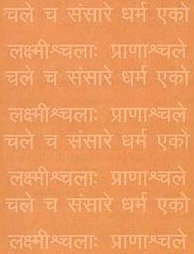
Nyaya (न्याय, nyaya) refers to a school of Hindu philosophy (astika), drawing its subject-matter from the Upanishads. The Nyaya philosophy is known for its theories on logic, methodology and epistemology, however, it is closely related with Vaisheshika in terms of metaphysics.
Ayurveda (science of life)
Source: archive.org: Vagbhata’s Ashtanga Hridaya Samhita (first 5 chapters)Smṛti (स्मृति) refers to “memory”, as mentioned in verse 5.37-39 of the Aṣṭāṅgahṛdayasaṃhitā (Sūtrasthāna) by Vāgbhaṭa.—Accordingly, “[...] [ghee is] recommended for wit, memory [viz., smṛti], intellect, digestion, strength, longevity, sperm, eyes, [...]: ghee [viz., ghṛta] (is) possessed of a thousand powers (and), by its (many) ways of application, productive of a thousand effects”.
Note: Dhī (“wit”), smṛti (“memory”), medhā (“intellect”), and—a little later—svara (“voice”) have been specified by suitable attributes: blo rno (“sharp wit”), dran gsal (“bright memory”), yid gźuṅs (“keen intellect”), and skad sñan (“melodious voice”).
Source: gurumukhi.ru: Ayurveda glossary of termsSmṛti (स्मृति):—It means memory / reminiscence / recollection. Is that which results from a particular conjunction between the soul and mind and also from impression. Acc to Charaka memory is nothing but the remembrance of the things directly perceived, heard (scriptures) or explained earlier.

Āyurveda (आयुर्वेद, ayurveda) is a branch of Indian science dealing with medicine, herbalism, taxology, anatomy, surgery, alchemy and related topics. Traditional practice of Āyurveda in ancient India dates back to at least the first millenium BC. Literature is commonly written in Sanskrit using various poetic metres.
Sports, Arts and Entertainment (wordly enjoyments)
Source: archive.org: Syainika Sastra of Rudradeva with English Translation (art)Smṛti (स्मृति) refers to “recollections of the past”, according to the Śyainika-śāstra: a Sanskrit treatise dealing with the divisions and benefits of Hunting and Hawking, written by Rājā Rudradeva (or Candradeva) in possibly the 13th century.—Accordingly, “Hunting on horseback (āśvina) represents one of the eight subdivisions of Hunting (mṛgayā). [...] But something should be said in brief about hunting, for the diffusion of its knowledge. [...] If unsuccessful the disappointment is great and it leads to needless apprehension of evil recollections of the past (smṛti), a change of complexion and lamentation. These and other things happen therefore equally both in hunting and in the love of women Therefore hunting, too, is desirable for the attainment of the three objects of life. [...]”.

This section covers the skills and profiencies of the Kalas (“performing arts”) and Shastras (“sciences”) involving ancient Indian traditions of sports, games, arts, entertainment, love-making and other means of wordly enjoyments. Traditionally these topics were dealt with in Sanskrit treatises explaing the philosophy and the justification of enjoying the pleasures of the senses.
General definition (in Hinduism)
Source: WikiPedia: HinduismSmriti (Sanskrit: स्मृति, Smṛti) literally "that which is remembered," refers to a specific body of Hindu religious scripture, and is a codified component of Hindu customary law. Smṛti also denotes non-Śruti texts and is generally seen as secondary in authority to Śruti. The literature which comprises the Smrti was composed after the Vedas around 500 BCE. Smrti also denotes tradition in the sense that it portrays the traditions of the rules on dharma, especially those of lawful virtuous persons.
There are two important sides of Smriti: Smriti as Tradition and Smriti as Texts.
- Smriti as Tradition consists of Smriti as memories. It is from these memories that the rules of dharma are preserved and passed down.
- Conversely, Smriti as Texts refers to the notion of Traditional Texts. These consists of mostly the dharmasastras and are described as literature which has been “inspired by the smrti”.
Smṛti — lit. “What is remembered” – refers to the Law Books all of which have human authors and which have more specific injunctions covering every aspect of one’s life, social, domestic as well as political and criminal.
Source: Institute of Sri Ramchandra Consciousness: A Handbook of Hindu Religion: LiteratureSmṛti (स्मृति):—If śruti is what is directly revealed to the Ṛṣis, the smṛti is what is recollected by them and recorded afterwards. The traditonal number of Smṛtis or law books is eighteen. They are
- Manusmṛti,
- Parāsarasmṛti,
- Vasiṣṭhasmṛti,
- Śaṅkhasmṛti,
- Likhitasmṛti,
- Atrismṛti,
- Viṣṇusmṛti,
- Hāritasmṛti,
- Yamasmṛti,
- Aṅgirassmṛti,
- Uśanassmṛti,
- Samvartasmṛti,
- Bṛhaspatlsmṛti,
- Kātyāyanasmṛti,
- Dakṣasmṛti,
- Vyāsasmṛti,
- Yājnavalkyasmṛti
- and Sātātapasmṛti (Śātātapasmṛti?).
All these Smṛtis are equally authoritative but the Manusmṛti has commanded universal respect from the authors of all other Smṛtis and authors of the Itihāsas and Purāṇas because it is the most comprehensive and the most elucidative or clear. The Parāśarasmṛti, is considered to be the standard work for this Kali age. It enumerates exhaustively the special rules for the Kali age. It is said in the Manusmṛti itself that Manu’s laws apply to the Kṛtayuga, Gautama’s laws to the Tretāyuga, the laws of Śaṅkha and Likhita to the Dvāparayuga and those of Parāśara to the Kaliyuga.
In Buddhism
Mahayana (major branch of Buddhism)
Source: Wisdom Library: Maha Prajnaparamita Sastra1) Smṛti (स्मृति, “mindfulness”) refers to one of the “five dharma practices” (pañcāṅga) for obtaining the first dhyāna according to the 2nd century Mahāprajñāpāramitāśāstra (chapter XXVIII). Accordingly, “Smṛti is mindfulness applied to the happiness of the first dhyāna. The ascetic knows that kāmadhātu is impure, deceptive, contemptible, whereas the first dhyāna is estimable and laudable”.
2) Smṛti (स्मृति, “mindfulness”) refers to one of ten constituents (dravya) of the thirty-seven auxiliaries to enlightenment (bodhipākṣika), according to chapter XXXI.—Accordingly, “these thirty-seven auxiliaries (bodhipākṣika) have ten things (dravya) as roots (mūla). Mindfulness (smṛti) constitutes: a. the faculty of mindfulness (smṛtīndriya); b. the power of mindfulness (smṛtibala); c. the factor-of-enlightenment called mindfulness (smṛti-saṃbodhyaṅga); d. the [factor-of-the-path] called right mindfulness (samyaksmṛti)”.
3) Smṛti (स्मृति, “mindfulness”) refers to one of the twenty-two faculties (indriya), according to chapter 38. The word indriya, derived from the root id or ind, is synonymous with great power, with control. The twenty-two Dharmas in question [viz., smṛti] have the characteristic of being dominant in regard to the living being (sattva) in that which concerns: his primary constitution, his distinctiveness, his duration, his moral defilement and his purification.
Source: academia.edu: A Study and Translation of the GaganagañjaparipṛcchāSmṛti (स्मृति) refers to “recollection”, according to the Gaganagañjaparipṛcchā: the eighth chapter of the Mahāsaṃnipāta (a collection of Mahāyāna Buddhist Sūtras).—Accordingly as The Lord said: “O Śāriputra, in the buddha-field of the Tathāgata Ekaratnavyūha, there is a Bodhisattva, the great being Gaganagañja who is resplendent by the splendor of merit (puṇya-tejas), [...] who is adorned with recollection (smṛti) because of his learning (śruti), is adorned with truth (satya) because of his introspection (nidhyapti), who is adorned with the understanding of meaning (arthagati) because of understanding (gati), who is adorned with promises because of intention (āśaya), [...]”.
Source: WikiPedia: Mahayana Buddhism1) Smṛti (स्मृति) (Tibetan: dran-pa) refers to “mindfulness” (which is applied as an antidote for forgetting the instruction), and represents one of the eight Pratipakṣa (“applications”) or Abhisaṃskāra (“applications”) (applied to overcome the five faults), according to Kamalaśīla and the Śrāvakabhūmi section of the Yogācārabhūmi-śāstra.
2) Smṛti (स्मृति) or Smṛtibala refers to the “power of mindfulness” representing one of the six Bala (“powers”) connected with śamatha (“access concentration”).

Mahayana (महायान, mahāyāna) is a major branch of Buddhism focusing on the path of a Bodhisattva (spiritual aspirants/ enlightened beings). Extant literature is vast and primarely composed in the Sanskrit language. There are many sūtras of which some of the earliest are the various Prajñāpāramitā sūtras.
General definition (in Buddhism)
Source: Wisdom Library: Dharma-samgrahaSmṛti (स्मृति, “mindfulness”) refers to one of the fourty “conditions” (saṃskāra) that are “associated with mind” (citta-samprayukta) as defined in the Dharma-saṃgraha (section 30). The Dharma-samgraha (Dharmasangraha) is an extensive glossary of Buddhist technical terms in Sanskrit (e.g., smṛti). The work is attributed to Nagarjuna who lived around the 2nd century A.D.
Smṛti also refers to one of the “five faculties” (pañcendriya), one of the “five strengths” (pañcabala) as well as one of the “seven factors of awakening” (bodhyaṅga), as defined in the Dharma-saṃgraha (section 47-49), all forming part of the “thirty-seven things on the side of awakening” (bodhipākṣika-dharma).
Smṛti also refers to one of the “eight practices for the abandoning of conditions” (saṃskāra) as defined in the Dharma-saṃgraha (section 119).
In Jainism
General definition (in Jainism)
Source: Encyclopedia of Jainism: Tattvartha SutraSmṛti (स्मृति, “remembrance”).—What is remembrance (smṛti)? Remembering/ recollecting or knowing from past experience is remembrance. What is the function of smṛti? The function of smr.ti is to recollect now the entities known earlier.

Jainism is an Indian religion of Dharma whose doctrine revolves around harmlessness (ahimsa) towards every living being. The two major branches (Digambara and Svetambara) of Jainism stimulate self-control (or, shramana, ‘self-reliance’) and spiritual development through a path of peace for the soul to progess to the ultimate goal.
Languages of India and abroad
Marathi-English dictionary
Source: DDSA: The Molesworth Marathi and English Dictionarysmṛti (स्मृति).—f (S)pop. smṛta f Recollection, reminiscence: also remembrance or memory. Used throughout as smaraṇa, where see at large. 2 Law,--the body of law as delivered originally by manu and other legislators to their respective pupils, and committed by them from recollection to writing: also any book, canon, or portion of this body or code.
Source: DDSA: The Aryabhusan school dictionary, Marathi-Englishsmṛti (स्मृति) [-ta, -त].—f Recollection; memory; law delivered by manu.
Marathi is an Indo-European language having over 70 million native speakers people in (predominantly) Maharashtra India. Marathi, like many other Indo-Aryan languages, evolved from early forms of Prakrit, which itself is a subset of Sanskrit, one of the most ancient languages of the world.
Sanskrit dictionary
Source: DDSA: The practical Sanskrit-English dictionarySmṛti (स्मृति).—f. [smṛ-ktin]
1) Remembrance; recollection, memory; अश्वत्थामा करधृतधनुः किं न यातः स्मृतिं ते (aśvatthāmā karadhṛtadhanuḥ kiṃ na yātaḥ smṛtiṃ te) Ve.3.21; संस्कारमात्रजन्यं ज्ञानं स्मृतिः (saṃskāramātrajanyaṃ jñānaṃ smṛtiḥ) T. S.; स्मृत्युपस्थितौ इमौ द्वौ श्लोकौ (smṛtyupasthitau imau dvau ślokau) Uttararāmacarita 6;4.2.
2) Thinking of, calling to mind.
3) What was delivered by human authors, law, traditional law, the body of traditional or memorial law (civil or religious) (opp. śruti).
4) A code of laws, law-book.
5) A text of Smṛti, canon, rule of law; इति स्मृतेः (iti smṛteḥ).
6) Desire, wish.
7) Discrimination, discretion; स्मृतौ हतायां भृतमानदुर्दृशः (smṛtau hatāyāṃ bhṛtamānadurdṛśaḥ) Bhāgavata 4.3.17.
8) Understanding.
Derivable forms: smṛtiḥ (स्मृतिः).
Source: Cologne Digital Sanskrit Dictionaries: Edgerton Buddhist Hybrid Sanskrit DictionarySmṛti (स्मृति).—f. (= Pali sati; hardly distinguishable from some aspects of Sanskrit id.), mindfulness, (full) consciousness or awareness, especially in samyak-s° = Pali sammā-sati, the 7th stage of the 8-fold Noble Path (mārga), in lists of its stages, such as Mahāvyutpatti 1003; Tibetan dran pa, which seems to parallel the various aspects of Sanskrit and [Buddhist Hybrid Sanskrit] smṛti. Cf. prec. and smṛtimant.
Source: Cologne Digital Sanskrit Dictionaries: Shabda-Sagara Sanskrit-English DictionarySmṛti (स्मृति).—f.
(-tiḥ) 1. Recollection, remembrance, memory. 2. Law, the body of law, (civil and religious,) as delivered originally by Manu- Yajnawalkya and other inspired legislators, to their respective pupils, and committed by them from recollection to writing, (as opposed to śruti or revelation.) 3. A law-book, a code of laws. 4. Wish, desire. 5. Understanding. E. smṛ to remember, aff. ktin .
Source: Cologne Digital Sanskrit Dictionaries: Benfey Sanskrit-English DictionarySmṛti (स्मृति).—[smṛ + ti], f. 1. Recollection, remembrance, memory, [Hitopadeśa] iv. [distich] 96; [Bhagavadgītā, (ed. Schlegel.)] 2, 63; Bhāṣāp. 47; [Rājataraṅgiṇī] 5, 5; [Uttara Rāmacarita, 2. ed. Calc., 1862.] 100, 14. 2. The body of law, as delivered originally by tradition; tradition, [Mānavadharmaśāstra] 2, 6; [Pañcatantra] 164, 20. 3. A law book. 4. A passage concerning law, [Vedāntasāra, (in my Chrestomathy.)] in
Smṛti (स्मृति).—[feminine] remembrance, memory, tradition ([opposed] śruti revelation); a class of works based on authoritative tradition.
Source: Cologne Digital Sanskrit Dictionaries: Aufrecht Catalogus CatalogorumSmṛti (स्मृति) as mentioned in Aufrecht’s Catalogus Catalogorum:—the 18 usual dharmaśāstra. Pheh. 2.
Source: Cologne Digital Sanskrit Dictionaries: Monier-Williams Sanskrit-English Dictionary1) Smṛti (स्मृति):—[from smṛ] f. remembrance, reminiscence, thinking of or upon ([locative case] or [compound]), calling to mind (smṛtim api te na yānti, ‘they are not even thought of’), memory, [Taittirīya-āraṇyaka; Chāndogya-upaniṣad; Mahābhārata] etc.
2) [v.s. ...] memory as one of the Vyabhicāri-bhāvas (q.v.), [Daśarūpa]
3) [v.s. ...] Memory (personified either as the daughter of Dakṣa and wife of Aṅgiras or as the daughter of Dharma and Medhā), [Harivaṃśa; Purāṇa]
4) [v.s. ...] the whole body of sacred tradition or what is remembered by human teachers (in contradistinction to śruti or what is directly heard or revealed to the Ṛṣis; in its widest acceptation this use of the term Smṛti includes the 6 Vedāṅgas, the Sūtras both śrauta and gṛhya, the law-books of Manu etc. [see next]; the Itihāsas e.g. the Mahābhārata and Rāmāyaṇa, the Purāṇas and the Nītiśāstras; iti smṛteḥ, ‘accord. to such and such a traditional precept or legal text’), [Indian Wisdom, by Sir M. Monier-Williams 144, 145]
5) [v.s. ...] the whole body of codes of law as handed down memoriter or by tradition ([especially] the codes of Manu, Yājñavalkya and the 16 succeeding inspired lawgivers, viz. Atri, Viṣṇu, Hārīta, Uśanas or Śukra, Aṅgiras, Yama, Āpastamba, Saṃvarta, Kātyāyana, Bṛhas-pati, Parāśara, Vyāsa, Śaṅkha, Likhīta, Dakṣa and Gautama; all these lawgivers being held to be inspired and to have based their precepts on the Veda; cf. [Indian Wisdom, by Sir M. Monier-Williams 203]), [Gṛhya-sūtra and śrauta-sūtra; Manu-smṛti; Yājñavalkya] etc.
6) [v.s. ...] symbolical Name for the number 18 ([from] the 18 lawgivers above)
7) [v.s. ...] a kind of metre, [cf. Lexicographers, esp. such as amarasiṃha, halāyudha, hemacandra, etc.]
8) [v.s. ...] Name of the letter g, [Upaniṣad]
9) [v.s. ...] desire, wish, [Pañcatantra iii, 258] ([varia lectio] for spṛhā).
Source: Cologne Digital Sanskrit Dictionaries: Yates Sanskrit-English DictionarySmṛti (स्मृति):—(tiḥ) 2. f. Recollection; the law, body of laws; wish; understanding.
Source: DDSA: Paia-sadda-mahannavo; a comprehensive Prakrit Hindi dictionary (S)Smṛti (स्मृति) in the Sanskrit language is related to the Prakrit words: Sai, Samii, Sui.
[Sanskrit to German]
Sanskrit, also spelled संस्कृतम् (saṃskṛtam), is an ancient language of India commonly seen as the grandmother of the Indo-European language family (even English!). Closely allied with Prakrit and Pali, Sanskrit is more exhaustive in both grammar and terms and has the most extensive collection of literature in the world, greatly surpassing its sister-languages Greek and Latin.
Hindi dictionary
Source: DDSA: A practical Hindi-English dictionarySmṛti (स्मृति) [Also spelled smrati]:—(nf) memory, remembrance; books of traditional code of Hindu law (as [manusmṛti, yājñavalkya-smṛti] etc.) said to be 18 in number; ~[kāra] author of Smriti (as [manu, yājñavalkya] etc.); -[cihna] a souvenir; -[patra] a reminder; ~[bhraṃśa/lopa] amnesia, loss of memory; ~[vid] well-versed in the code of law defined in the Smritis; -[śāstra] the science of Hindu code of law as given in the Smritis; ~[śāstrajña] well-versed in the Smritis; ~[śeṣa] living only in memory, late; ~[sammata] approved by or enjoined in the Smritis; ~[hīna] oblivious, forgetful; ~[hīnatā] amnesia; obliviousness, forgetfulness.
...
Kannada-English dictionary
Source: Alar: Kannada-English corpusSmṛti (ಸ್ಮೃತಿ):—
1) [noun] rememberance; reminiscence.
2) [noun] the power or ability to remember.
3) [noun] the knowledge one received by one’s practical experience.
4) [noun] the state of being conscious; awareness of one’s own feelings, what is happening around one, etc.; consciousness.
5) [noun] the whole body of codes of law memorised and handed down by tradition.
6) [noun] the rules or prescriptions laid by these codes of law.
7) [noun] (rhet.) memory as one of the thirty three minor sentiments.
Kannada is a Dravidian language (as opposed to the Indo-European language family) mainly spoken in the southwestern region of India.
See also (Relevant definitions)
Starts with (+151): Smriti-patra, Smritibala, Smritibhaskara, Smritibhramsha, Smritibhu, Smritibodhyanga, Smriticandra, Smriticandrika, Smriticandrodaya, Smriticarana, Smriticaranabhashya, Smritichandrika, Smriticintamani, Smriticudamanisamgraha, Smritida, Smritidarpana, Smritidarshamna, Smritidipa, Smritidipika, Smritidrishta.
Ends with (+163): Acaryasmriti, Agnismriti, Amritasmriti, Amtahsmriti, Anapanasmriti, Angirahsmriti, Anusmriti, Apagamasmriti, Apasmriti, Apastambasmriti, Apastasmriti, Arunasmriti, Ashtadashasmriti, Ashvalayanasmriti, Asmriti, Atreyasmriti, Atrismriti, Aupakayanasmriti, Avismriti, Babhrusmriti.
Full-text (+7186): Smarta, Smritishastra, Smrati, Smritivirodha, Smriti-patra, Anumati, Aptashruti, Praticodana, Smrityapeta, Smritiviruddha, Smritisammata, Smart, Prasmriti, Apasmriti, Smritibhramsha, Smritimat, Smriticintamani, Mahasmriti, Papiyas, Shivasmriti.
Relevant text
Search found 194 books and stories containing Smriti, Smṛti, Smrti; (plurals include: Smritis, Smṛtis, Smrtis). You can also click to the full overview containing English textual excerpts. Below are direct links for the most relevant articles:
Sahitya-kaumudi by Baladeva Vidyabhushana (by Gaurapada Dāsa)
Text 11.44 < [Chapter 11 - Additional Ornaments]
Text 4.48 < [Chapter 4 - First-rate Poetry]
Text 4.35 < [Chapter 4 - First-rate Poetry]
Brahma Sutras (Shankara Bhashya) (by Swami Vireshwarananda)
Chapter II, Section I, Adhikarana I < [Section I]
Chapter IV, Section II, Adhikarana XI < [Section II]
Chapter II, Section III, Adhikarana XVII < [Section III]
Yajnavalkya-smriti (Vyavaharadhyaya)—Critical study (by Kalita Nabanita)
Chapter 1.1a - Meaning of the Term smṛti < [Chapter 1 - Introduction]
Chapter 2.1b - Sources of Dharma < [Chapter 2 - The Vyavahārādhyāya of the Yājñavalkyasmṛti]
Chapter 2.1d - Difference between Dharma and Vyavahāra < [Chapter 2 - The Vyavahārādhyāya of the Yājñavalkyasmṛti]
Vasudevavijaya of Vasudeva (Study) (by Sajitha. A)
Dharmaśāstra (the Dharmasūtras and Smṛtis) < [Chapter 5 - Impact of other Disciplines in Vāsudevavijaya]
Padacandrikā—The auto commentary < [Chapter 2 - Vāsudevavijaya—Authorship and Content Analysis]
Uṇādi-sūtras (Grammar rules) < [Chapter 3 - Vāsudevavijaya—A Grammatical Study]
Tattvartha Sutra (with commentary) (by Vijay K. Jain)
Verse 1.13 - Synonyms of sensory-knowledge (matijñāna) < [Chapter 1 - Right Faith and Knowledge]
Manusmriti with the Commentary of Medhatithi (by Ganganatha Jha)
Verse 2.6 < [Section III - Sources of Knowledge of Dharma]
Verse 2.114 < [Section XXII - Specially qualified Pupils]
Verse 2.10 < [Section III - Sources of Knowledge of Dharma]
Related products
